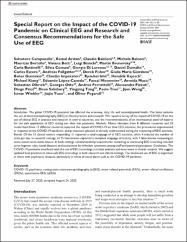Special report on the impact of the COVID-19 pandemic on clinical EEG and research and consensus recommendations for the safe use of EEG

Göster/
Erişim
info:eu-repo/semantics/openAccessTarih
2021Yazar
Campanella, SalvatoreArıkan, Kemal
Babiloni, Claudio
Balconi, Michela
Bertollo, Maurizio
Betti, Viviana
Bianchi, Luigi
Brunovsky, Martin
Buttinelli, Carla
Comani, Silvia
Di Lorenzo, Giorgio
Dumalin, Daniel
Escera, Carles
Fallgatter, Andreas
Fisher, Derek
Giordano, Giulia Maria
Güntekin, Bahar
Imperatori, Claudio
Ishii, Ryouhei
Kajosch, Hendrik
Kiang, Michael
Lopez-Caneda, Eduardo
Missonnier, Pascal
Mucci, Armida
Olbrich, Sebastian
Otte, Georges
Perrottelli, Andrea
Pizzuti, Alessandra
Pinal, Diego
Salisbury, Dean
Tang, Yingying
Tisei, Paolo
Wang, Jijun
Winkler, Istvan
Yuan, Jiajin
Pogarell, Oliver
Üst veri
Tüm öğe kaydını gösterKünye
Campanella, S., Arıkan, K., Babiloni, C., Balconi, M., Bertollo, M., Betti, V. ... Pogarell, O. (2021). Special report on the impact of the COVID-19 pandemic on clinical EEG and research and consensus recommendations for the safe use of EEG. Clinical EEG and Neuroscience, 52(1), 3-28. https://dx.doi.org/10.1177/1550059420954054Özet
Introduction. The global COVID-19 pandemic has affected the economy, daily life, and mental/physical health. The latter includes the use of electroencephalography (EEG) in clinical practice and research. We report a survey of the impact of COVID-19 on the use of clinical EEG in practice and research in several countries, and the recommendations of an international panel of experts for the safe application of EEG during and after this pandemic.Methods. Fifteen clinicians from 8 different countries and 25 researchers from 13 different countries reported the impact of COVID-19 on their EEG activities, the procedures implemented in response to the COVID-19 pandemic, and precautions planned or already implemented during the reopening of EEG activities.Results. Of the 15 clinical centers responding, 11 reported a total stoppage of all EEG activities, while 4 reduced the number of tests per day. In research settings, all 25 laboratories reported a complete stoppage of activity, with 7 laboratories reopening to some extent since initial closure. In both settings, recommended precautions for restarting or continuing EEG recording included strict hygienic rules, social distance, and assessment for infection symptoms among staff and patients/participants.Conclusions. The COVID-19 pandemic interfered with the use of EEG recordings in clinical practice and even more in clinical research. We suggest updated best practices to allow safe EEG recordings in both research and clinical settings. The continued use of EEG is important in those with psychiatric diseases, particularly in times of social alarm such as the COVID-19 pandemic.

















